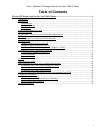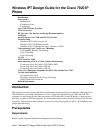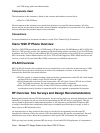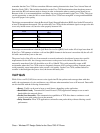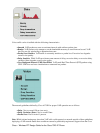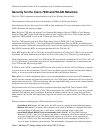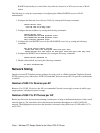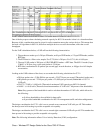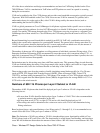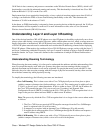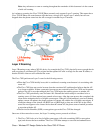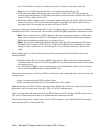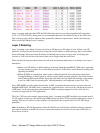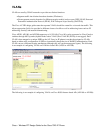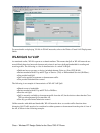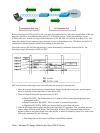
One of the key aspects when calculating network capacity for 802.11b networks is that it is a shared medium.
Because of this, consideration must be given for radio contention among the various devices. This means that
the back−off algorithms in 802.11b, that allow multiple devices to access the medium, affect the overall
throughput.
For the VoIP calculations below, a VoIP call has the following characteristics:
The packets are made up of a 20 byte IP header, an 8 byte UDP header, a 12 byte RTP header, and the
RTP data.
1.
The RTP data is a 20ms voice sample. For G.729, this is 20 bytes. For G.711, this is 160 bytes.2.
The total VoIP packet is 200 bytes of (IP+UDP+RTP) headers + RTP data. The 802.11 header (Layer
2 MAC) is 24 bytes long, so the total packet is 224 bytes.
3.
RTP data is transmitted at 50 packets per second (pps) in each direction, or 100pps for a full−duplex
conversation.
4.
Looking at the 11Mb column of the chart, we can make the following calculations for G.711:
256 byte packet size = 2,596,588 bits per second = 324,573 bytes per second (Theoretical packet rate)•
100 packets per second * 224 bytes per packet = 22,400 bytes per second (Bandwidth of a G.711
VoIP call)
•
324,573 / 22,400 = 14.489 calls (Theoretical maximum VoIP capacity per 802.11b channel)•
14.489 * .6 = 8.69 calls (Theoretical maximum number of VoIP calls * 60 percent of the bandwidth)
Note: Sixty percent of the bandwidth is used to calculate the number of VoIP calls, which allows for
the following:
It allows bandwidth to be available for data traffic.♦
It provides bandwidth consideration for 802.11b management traffic and acknowledgements.♦
•
The design consideration for G.711 calls is not to exceed seven concurrent VoIP calls per AP. This number
has been proven in lab testing to provide acceptable voice quality.
The design consideration for G.729 calls is not to exceed eight concurrent VoIP calls per AP. This number has
been proven in lab testing to provide acceptable voice quality.
Note: The following information affects Voice Activity Detection (VAD) configuration:
Cisco − Wireless IPT Design Guide for the Cisco 7920 IP Phone



